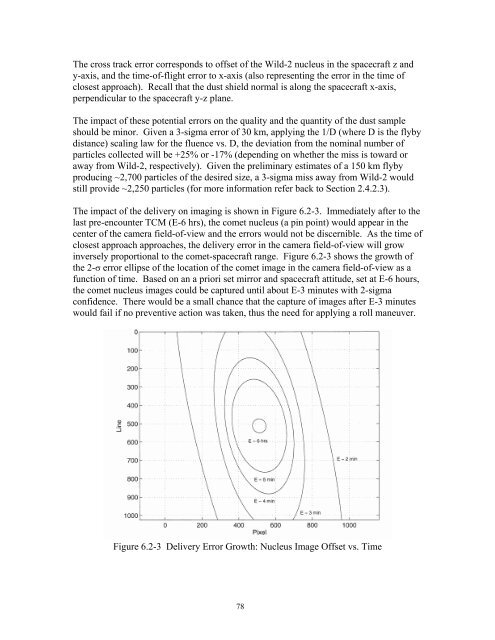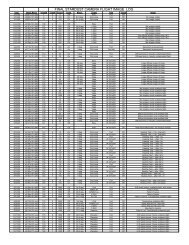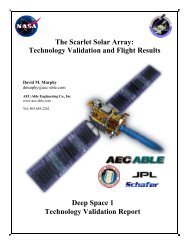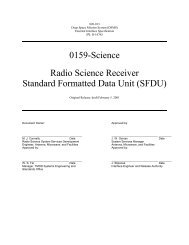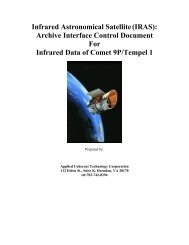MISSION PLAN - PDS Small Bodies Node
MISSION PLAN - PDS Small Bodies Node
MISSION PLAN - PDS Small Bodies Node
Create successful ePaper yourself
Turn your PDF publications into a flip-book with our unique Google optimized e-Paper software.
The cross track error corresponds to offset of the Wild-2 nucleus in the spacecraft z and<br />
y-axis, and the time-of-flight error to x-axis (also representing the error in the time of<br />
closest approach). Recall that the dust shield normal is along the spacecraft x-axis,<br />
perpendicular to the spacecraft y-z plane.<br />
The impact of these potential errors on the quality and the quantity of the dust sample<br />
should be minor. Given a 3-sigma error of 30 km, applying the 1/D (where D is the flyby<br />
distance) scaling law for the fluence vs. D, the deviation from the nominal number of<br />
particles collected will be +25% or -17% (depending on whether the miss is toward or<br />
away from Wild-2, respectively). Given the preliminary estimates of a 150 km flyby<br />
producing ~2,700 particles of the desired size, a 3-sigma miss away from Wild-2 would<br />
still provide ~2,250 particles (for more information refer back to Section 2.4.2.3).<br />
The impact of the delivery on imaging is shown in Figure 6.2-3. Immediately after to the<br />
last pre-encounter TCM (E-6 hrs), the comet nucleus (a pin point) would appear in the<br />
center of the camera field-of-view and the errors would not be discernible. As the time of<br />
closest approach approaches, the delivery error in the camera field-of-view will grow<br />
inversely proportional to the comet-spacecraft range. Figure 6.2-3 shows the growth of<br />
the 2-σ error ellipse of the location of the comet image in the camera field-of-view as a<br />
function of time. Based on an a priori set mirror and spacecraft attitude, set at E-6 hours,<br />
the comet nucleus images could be captured until about E-3 minutes with 2-sigma<br />
confidence. There would be a small chance that the capture of images after E-3 minutes<br />
would fail if no preventive action was taken, thus the need for applying a roll maneuver.<br />
Figure 6.2-3 Delivery Error Growth: Nucleus Image Offset vs. Time<br />
78


